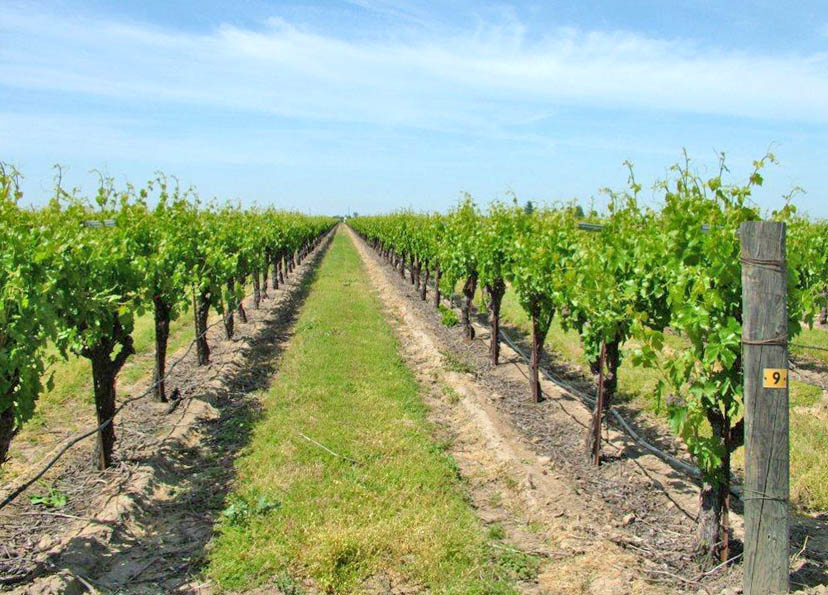August 31, 2012

In orchards and vineyards of the future, one sensor will measure the amount of photosynthetic energy being absorbed by tree and vine canopies at any time of day. Still others will sense moisture levels from leaves and soil. A variable-rate irrigation system can then supply just the right amount of water and fertilizer, depending on what a particular plant needs. And all the information can be collected, processed and seen by growers in real time through their mobile devices so they can make informed decisions quickly.
Washington State University’s Center for Precision and Automated Agricultural Systems is working with University of California at Davis and others on a three-year, $2.6 million U.S. Department of Agriculture project to bring this future to the present.
“This research is aimed at developing and integrating soil- and plant-based sensors to monitor the state and condition of plant canopies for optimizing management within orchards and vineyards,” said Qin Zhang, WSU CPAAS director. “The importance of this research to Washington’s wine grape and tree fruit industries is that the profitability of the industry is strongly dependent on the production of high-quality fruit, which is associated with a proper balance of canopy and crop load.”
Project researchers are developing a farm-based, precision management system to help specialty crop growers improve quality and increase production efficiency while reducing their environmental footprint. The project has seven objectives, of which WSU is participating in five:
Mobile platform for measuring canopy architecture and photosynthetically active radiation (PAR) absorption. PAR is necessary for photosynthesis and plant growth. In orchards, researchers have studied the relationship between the amount of this energy canopies absorb and increasing productivity. The information gathered from the platform—equipped with a GPS receiver, radar and infrared thermometers—can be used to determine the effect of canopy management on yield, quality and more.
WSU researchers took the PAR absorption study a step further when they evaluated sweet cherry trees trained to new, two-dimensional fruiting wall architectures at the WSU Roza Research Orchard near Prosser. They found that trees trained to a Y trellis absorbed more light over the course of a day than trees trained to an upright fruiting offshoot (UFO) system.
“It could provide the fundamental information needed to improve both fruit yield and quality in a UFO system by carefully planning the pruning of trees,” Zhang said.
Sensor suite for detecting plant and soil water status. Sensors for infrared temperature, PAR, wind speed, relative humidity and ambient air temperature make up the suite. An in-ground probe measures soil moisture, electrical conductivity, organic matter and compaction.
WSU is also investigating modifications to the suite to monitor water stress of grapevines. Additions include infrared thermography to detect temperature distribution patterns of sunlit and shaded canopies, as well as a handheld light bar and multispectral camera to measure PAR absorption under different water stress levels.
Decision support system. WSU has created a prototype software analysis tool so participating growers and university researchers can assimilate and rapidly act on the information they receive from sensing devices in the field. The tool can import and integrate a wide variety of data in different formats, including time, location, temperatures and other readings; process the information and show results specific to a grower’s farming operation; and support a range of Internet-connected mobile devices, such as a smart phone or tablet.
“This is a very challenging task,” Zhang said. “We’re giving growers the basic algorithm, and they can choose the interface. Some want a paper copy of the data analysis; others want it on their iPhone. Some want results in color; others in black and white. Some want to see something in 3-D; others in 2-D. It’s difficult to please everybody. The important thing is to make the information available visually in real time.”
Variable-rate irrigation
Variable-rate irrigation system. A network of wireless sensors and controllers manages irrigation so a tree or group of trees receives only the amount of water and fertilizer needed. WSU is evaluating the system on grapes in a test plot at the WSU Roza Research Orchard. Part of the evaluation will include studying the effects on berry size and phenolic content when grapes are not irrigated early in the growing season.
Social impact study. WSU has developed a 22-question survey to assess what growers think of the sensors and technologies that are part of the project. Questions address canopy and irrigation management in orchards and vineyards, the two major needs stakeholders have identified.
According to UC Davis, the long-term goal of the project is to establish the foundation for precise management of specialty crops at levels unattainable with satellite-based and aerial sensing. For details about its full scope, visit the project website.
“We envision the creation of an information-based, decision-making infrastructure that will drive Washington’s tree fruit and wine grape industries into this new precision agriculture revolution, an era of precision crop management,” Zhang said.
University of Arizona, New Mexico State University, Veris Technologies Inc., Oregon State University, AgInformatics LLC and Trimble Navigation Ltd. are also project investigators. Other participating agencies and producers include the Almond Board of California, California Walnut Board, Christensen Farms LLC, Constellation Wines, Olsen Brothers Ranches Inc., USDA and the Washington Tree Fruit Research Commission.
WSU CPAAS, established in 1999 as the WSU Center for Precision Agricultural Systems, promotes creative research and extension activities for more effective growing, harvesting and processing of specialty crops through mechanization and automation. For more information, visit the WSU CPAAS website.
You May Also Like




